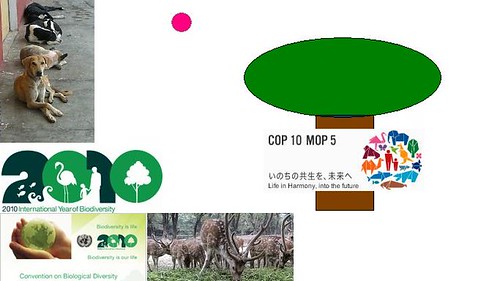#ParliamentOfStudentsOnEnvironment 2015 will be held on Dec 05 in #Etawah, India. Message invited for #GreenWarriors.
https://www.facebook.com/events/175342659482513/
Red Tape Movement
This blog is for the followers of RED TAPE MOVEMENT. This movement is running for the saving of the existing trees by binding red tape on tree stem.
Saturday, November 28, 2015
Parliament of Students on Environment 2015
Friday, December 12, 2014
Thursday, May 23, 2013
Green alert
My article on current new level of 400ppm of CO2:
 Green alert: World reaches sad milestone
Green alert: World reaches sad milestone
Prabhat Misra
Hindustan Times (Lucknow)
May 16 2013
On May 9, 2013, atmospheric carbon dioxide concentration hit the level of 400 parts per million (ppm). This new level is 50 ppm higher than the ‘safer’ level of 350 ppm. This new number means that there are 400 molecules of carbon dioxide in the air...read more...
Copyright © 2013 HT Media Limited. All Rights Reserved.
Prabhat Misra
Hindustan Times (Lucknow)
May 16 2013
On May 9, 2013, atmospheric carbon dioxide concentration hit the level of 400 parts per million (ppm). This new level is 50 ppm higher than the ‘safer’ level of 350 ppm. This new number means that there are 400 molecules of carbon dioxide in the air...read more...
Copyright © 2013 HT Media Limited. All Rights Reserved.
Biodiversity- current status
Following is my article on BIODIVERSITY:
 The current status of biodiversity
The current status of biodiversity
(The writer is assistant director savings, Etawah). VIEWS OF THE WRITER ARE PERSONAL.
Hindustan Times (Lucknow)
May 23 2013
Biological diversity or biodiversity is a term we use to describe the variety of life on Earth, according to the International Union for Conservation of Nature (IUCN). It refers to the wide variety of ecosystems and living organisms: animals, plants,...read more...
Copyright © 2013 HT Media Limited. All Rights Reserved.
(The writer is assistant director savings, Etawah). VIEWS OF THE WRITER ARE PERSONAL.
Hindustan Times (Lucknow)
May 23 2013
Biological diversity or biodiversity is a term we use to describe the variety of life on Earth, according to the International Union for Conservation of Nature (IUCN). It refers to the wide variety of ecosystems and living organisms: animals, plants,...read more...
Copyright © 2013 HT Media Limited. All Rights Reserved.
Sunday, May 12, 2013
May 9, 2013
On 9th May 2013, atmosphericCO2 concentration hit 400 ppm. The number means there are 400 molecules of
carbon dioxide in the air per every million air molecules. This happens first time in human history.The National Oceanic and Atmospheric
Administration (NOAA) announced on 10th May, 2013. Carbondioxide and other greenhouse gases warm the planet by absorbing the sun’s energy and preventing heat from
escaping back into space. Once emitted, CO2 added to the atmosphere and oceans remainsfor thousands of years.
Thus, climate changes forced by CO2 dependprimarily on cumulative emissions, making it progressively more and more
difficult to avoid further substantial climate change. Dr James "Jim" Hansen calculated global warming traps heat equal to energy by 400,000 Hiroshima atomic bombs explosion/ day. Al Gore urged on 10th May "Take this day and the milestone it
represents to reflect on the fragility of our civilization and and the
planetary ecosystem on which it depends……….We must take immediate action to
solve this crisis. Not tomorrow, not next week, not next year. Now."
Tuesday, February 26, 2013
Thursday, January 3, 2013
News about Red Tape Movement has been published in Hindustan Times, 03 Jan 2013
News about Red Tape Movement has been published in Hindustan Times, 03 Jan 2013, was published in Lucknow edition, on page number 5. Thanks Hindustan Times.
Hindustan Times (Lucknow)
3 Jan 2013

Hindustan Times (Lucknow)
3 Jan 2013
Wednesday, December 26, 2012
Biodiversity- a ray of hope?
Biodiversity—the variety of plants, animals and ecosystems in the world—is a measure of our planet’s health. Overexploitation of species, habitat destruction, and the introduction of invasive species are threatening Earth’s biodiversity. It’s time to turn the tide.

by worldbank.Learn about data visualization software.

Tuesday, November 6, 2012
Sunday, November 4, 2012
Thursday, November 1, 2012
Plant A Pledge- IUCN
Mankind has removed more than half of the planet's original forest cover. All the time this land stays barren and unrestored, the lives of millions of people and the survival of entire communities, cultures and ecosystems, remain under threat.
We can restore many of these landscapes. A restored landscape can accommodate a mosaic of different land uses. Forest and landscape restoration turns barren or degraded areas of land into healthy, fertile, working landscapes that can meet the needs of people and the natural environment.
In 2011, an international assembly of high-level representatives from governments, businesses and conservation groups set a target to restore 150 million hectares of degraded lands by 2020. This agreement is called the Bonn Challenge.
Reaching the target will demand the success of dozens, possibly hundreds of landscape restoration projects around the world.
It's going to take the biggest restoration initiative the world has ever seen.
And it will take pledges of support from millions of people, businesses and organisations to put pressure on governments to make it happen.
And it all starts when you Plant A Pledge with us today.
Source: IUCN and Plant A Pledge
Saturday, October 27, 2012
Big Achievement for Red Tape Movement
Dear Green Soldiers,
Big Achievement for Red Tape Movement.
Appreciation by an International Organization IUCN, on 26th October, 2012.
Red Tape Movement is thankful to IUCN for appreciation and support to Red Tape Movement. View tweet by IUCN at twitter site of IUCN.
I am also thankful to NGO "Swami Vivekanand Sewa Sansthan, Etawah", Mr. Sanjay Saxena, Dr. Rajeev Chauhan, Mr. Ravindra Dixit and all the supporters of this movement for their co-operation to reach this level.
I thank you.
Prabhat Misra
Big Achievement for Red Tape Movement.
Appreciation by an International Organization IUCN, on 26th October, 2012.
Red Tape Movement is thankful to IUCN for appreciation and support to Red Tape Movement. View tweet by IUCN at twitter site of IUCN.
I am also thankful to NGO "Swami Vivekanand Sewa Sansthan, Etawah", Mr. Sanjay Saxena, Dr. Rajeev Chauhan, Mr. Ravindra Dixit and all the supporters of this movement for their co-operation to reach this level.
I thank you.
Prabhat Misra
Monday, October 15, 2012
The Power of We: Red Tape Movement
My name is Prabhat Misra; I am in
government job as an officer in the district Etawah [U.P., India ]. I am also running a
peaceful and non-violent movement to save trees and bio-diversity, named
"RED TAPE MOVEMENT", in Etawah. This movement was started by me on
5th June, 2008. Under this movement, especially on a holiday, we choose a
village and go to this village and do plantation and then tie red tapes on
existing trees trunks, with the help of villagers and there, we give them
message that to cut the trees is lethal for our future and generations to come.
I started this movement with the help of a local N.G.O. named “Swami Vivekanand
Sewa Sansthan”, Etawah. Initially, we faced the problem of co-operation at grass
root level. Later, with continuous awareness campaign, regarding the importance
of trees and bio-diversity and dangers of Climate Change, at grass root level,
especially with villagers, positively changed the co-operation. Till now, we
have tied Red Tapes on about 10,000 trees trunks with the help of villagers.
Red Tape Movement has now taken a big shape, from few peoples to many peoples
co-operation, in the form of “Peoples Participation Movement”. Red Tape
Movement has also been the part of several actions such as Earth Day, Earth
Hour, 350.org’s Connect the Dots and many more days of action. Such people’s
participation movements are the need of the hour to save our biodiversity and
nature.
My experience about this movement
is very positive and energetic. We are living in a world which is under
“transition and transformation phase” of energy and facing the problem of
Climate Change. So, we must develop a better and natural “GHG Sink system” to
achieve 350 ppm CO2 level in the atmosphere. Trees are “Best Natural Sinks” of
CO2 and will be helpful to tackle with Climate Change. World Community should
keep one fundamental rule, while making any planning, that, “United We” can
save earth from Climate Change, through such peoples participatory grass root
level awareness movements. This is MUST to save our beautiful Earth from
Climate Change for our future generations to come. Red Tape movement is
now spreading fast at grass root level and peoples are supporting our move to
protect and save trees and bio-diversity.
Friday, October 12, 2012
Friday, March 9, 2012
Earth Hour in Etawah- 2012


On Earth Hour Day, we will organize Earth Hour in block Mahewa. The event will be organised in a ravine forest village named, "Aasayi" [Block- Mahewa, District- Etawah, Uttar Pradesh, India]. This development block is the FIRST DEVELOPMENT BLOCK of INDIA. Currently, i have the additional charge of B.D.O. [ Block Development Officer ] of Mahewa. On this day, we will tie the RED TAPES on trees trunks, through RED TAPE MOVEMENT, to give the message that to cut trees is DANGEROUS to the survival of life on this BLUE PLANET. RED TAPE MOVEMENT is run and was started by me to save trees and biodiversity, in Etawah. We will pursue grass root level people to switch off their bulbs, between the period of 8.30 P.M. to 9.30 P.M. on 31/03/2012
Saturday, September 24, 2011
Moving Planet - September 24th, 2011: A Day to Move Beyond Fossil Fuels
MOVE to SAVE; Join Red Tape Movement at http://www.moving-planet.org/events/in/etawah/428 on 24th Sept. 2011.
Friday, April 29, 2011
Monday, April 4, 2011
Appreciation from British Embassies
British Embassies of Guatemala City and Ukraine appreciated our work on Earth Hour on 24th March 2011. We are thankful to British Embassies of Guatemala City and Ukraine and their respective respected Ambassadors for the appreciation and also thankful to our savings agents and peoples of Ekdil town area. My special thanks to respected Mr. Vijyendra Pandian, I.A.S., Dr. Rajeev Chauhan, Environmentalist and Mr. Sanjay Saxena, Press Reporter for active participation.
Monday, March 21, 2011
Sunday, March 13, 2011
Earth Hour News: A message from our Global Ambassador Miranda Kerr
Earth Hour News: A message from our Global Ambassador Miranda Kerr: "I am pleased to have been asked to be the global ambassador for Earth Hour 2011. Each of us has a responsibility for the sustainability of..."
Wednesday, March 2, 2011
Saturday, February 19, 2011
The IUCN Forest Conservation Programme Newsletter Issue 42 2010
Read arborvitae newsletter to know that How sexy are forests? Read here.
Friday, February 18, 2011
Tuesday, February 15, 2011
Monday, February 14, 2011
Friday, February 11, 2011
Friday, February 4, 2011
IUCN - News

The 9th UN Forum on Forests (UNFF9) is drawing to a close. With just over 24 hours left, negotiators are entering lockdown to get a meaningful declaration in place for Friday's finish.
Stewart Maginnis is IUCN's head of delegation and IUCN's Director for Environment and Development. He explains just where the negotiations are at present.
Wednesday, February 2, 2011
World carbon dioxide emissions data
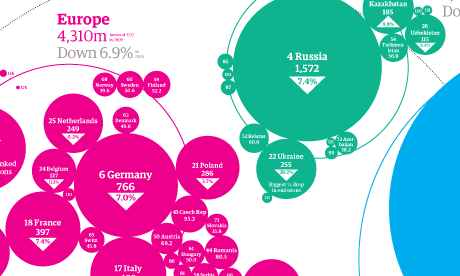
World carbon dioxide emissions are one way of measuring a country's economic growth too.
And the latest figures - published by the respected Energy Information Administration - show CO2 emissions from energy consumption - the vast majority of Carbon Dioxide produced............ Read the complete story HERE.
[Source: guardian]
Tuesday, February 1, 2011
WORLD WETLANDS DAY- 2nd Feb 2011


2 February each year is World Wetlands Day. It marks the date of the adoption of the Convention on Wetlands on 2 February 1971, in the Iranian city of Ramsar on the shores of the Caspian Sea. Each year since 1997, government agencies, non-governmental organizations, and groups of citizens at all levels of the community have taken advantage of the opportunity to undertake actions aimed at raising public awareness of wetland values and benefits in general and the Ramsar Convention in particular.
Wetlands are among the most productive ecosystems in the world, comparable to rain forests and coral reefs; they are found on every continent except Antarctica and from the tundra to the tropics. Due to typical functions like- wildlife habitat and food chain support, groundwater recharge, water purification, nutrient retention and flood control- wetlands are considered as "biological supermarkets", "nurseries of life" and "the kidneys of the landscape" (Barbier et al. 1997; Mitsch and Gosselink 1993). These are facing threats for existence; major threats are- anthropogenic activities, agriculture activities, deforestation, pesticides pollution, pollution, introduced species threats due to Eichhornia etc. Migrating birds use wetlands to rest and feed during their cross-continental journeys and as nesting sites when they are at home. As a result, wetland loss has a serious impact on these species.
The theme for World Wetlands Day 2011 is Wetlands and Forests and slogan is– Forests for water and wetlands. 2011 is a special year for Ramsar as we are celebrating our 40th anniversary. Best Wishes. Read the Message of Mr Anada Tiéga, Secretary General, Ramsar Convention, by clicking here and for Ramsar Sites in Google Earth click here.
[Source: Ramsar and Red Tape Movement]
Friday, January 21, 2011
Long-distance migration may help reduce infectious disease risks for many animal species
It's a common assumption that animal migration, like human travel across the globe, can transport pathogens long distances, in some cases increasing disease risks to humans. West Nile Virus, for example, spread rapidly along the East coast of the U.S., most likely due to the movements of migratory birds. But in a paper just published in the journal Science, researchers in the University of Georgia Odum School of Ecology report that in some cases, animal migrations could actually help reduce the spread and prevalence of disease and may even promote the evolution of less-virulent disease strains. Read detailed report here.
[Source: eurekalert]
[Source: eurekalert]
Expanding Sustainable Timber in Tanzania

There are many negative environmental impacts of globalization — increased pollution, depleted natural resources and an overtaxed food system, to name a few.
The East African blackwood tree (Dalbergia melanoxylon) — known as mpingo in Swahili — may sound exotic to people outside Africa, but chances are you’ve seen it. Its wood is prized for use in musical instruments like clarinets and bagpipes, as well as the traditional sculptures seen in African villages and on Western city streets. However, unregulated logging has seriously depleted much of the tree’s native habitat, posing a threat to the local economy as well as the species that dwell in these forests.
[Source: Conservation International Blog]
The Plant List: a working list of all known plant species

The Plant List is a working list of all known plant species. Version 1, released in December 2010, aims to be comprehensive for species of Vascular plant (flowering plants, conifers, ferns and their allies) and of Bryophytes (mosses and liverworts). It does not include algae or fungi. Version 1 contains 1,244,871 million scientific plant names of which 298,900 are accepted species names. It includes no vernacular or common plant names.
[Source: The Plant List]
Wednesday, January 19, 2011
Species loss tied to ecosystem collapse and recovery
Species loss tied to ecosystem collapse and recovery; Conservation biologists regularly note the precipitous decline of key species, such as cod, bluefin tuna, swordfish and sharks. Lose enough of these top-line predators (among other species), and the fear is that the oceanic web of life may collapse.
[Source: Brown University]
[Source: Brown University]
Saturday, January 15, 2011
Monday, January 3, 2011
Wednesday, November 10, 2010
Drug from evergreen tree kills cancer
The anticancer drug, called maytansine inhibit proliferation of breast cancer cells at mitosis. The Maytansine and its analogues maytansinoids are extraordinarily potent antitumor agents that were originally isolated from members of the higher plant families Celastraceae, Rhamnaceae, and Euphorbiaceae. The maytansinoids, a group of ansa macrocyclic lactams with potent antitumor activity, were first isolated from Maytanus species of family Celastraceae. This reasearch will open the new hope for breast cancer disease treatment.
[Source: science360.gov]
[Source: science360.gov]
Tuesday, November 9, 2010
Tuesday, November 2, 2010
Backyard Wetland
Build a wetland in your backyard. Learn how by visiting the U.S. Department of Agriculture’s web site.
Monday, November 1, 2010
Wetlands and Sarsai Nawar Wetland
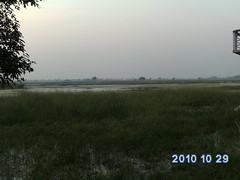

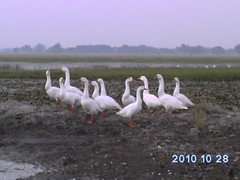
![Growers of Water Caltrop [Trapa natans], Singhara, in wetland area, Sarsai Nawar](http://farm2.static.flickr.com/1260/5129058668_a900f9cde5_m.jpg)
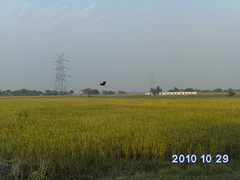
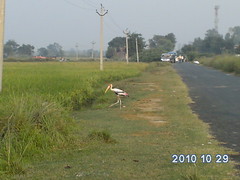
The Ramsar Convention (Article 1.1) defined wetlands as: “areas of marsh, fen, peat land, or water, whether natural or artificial, permanent or temporary, with water that is static or flowing, fresh, brackish or salt, including areas of marine water the depth of which at low tide doesn’t exceed six meters”. In addition, the convention (Article 2.1) provides that wetlands: “may incorporate riparian and coastal zones adjacent to the wetlands, and islands or bodies of marine water deeper than six meters at low tide lying within the wetlands. Wetlands are among the most productive ecosystems in the world, comparable to rain forests and coral reefs. In wetland ecosystem water is the primary factor controlling both the plant and animal life; they are found on every continent except Antarctica and from the tundra to the tropics . Wetlands fall into four general categories—marshes, swamps, bogs, and fens. Marshes are wetlands dominated by soft-stemmed vegetation, while swamps have mostly woody plants. Bogs are freshwater wetlands, often formed in old glacial lakes, characterized by spongy peat deposits, evergreen trees and shrubs, and a floor covered by a thick carpet of sphagnum moss. Fens are fresh water peat-forming wetlands covered mostly by grasses, sedges, reeds, and wild flowers. Wetlands favours particular type of trees, shrubby species and associated herbs and grasses with algae. Typical characteristic species of wetland ecosystem include hydrophytes such as Cyperus, Azolla, Nymphaea, Typha, Potamogoton, Wolffia, Phragmites, Eichhornia etc., and tree species include species of Ficus, Tamarindus indica, Mimusops, Syzygium, Terminalia, Acacia, Mangifera. An immense variety of species of insects, amphibians, reptiles, birds, fish, and mammals forms fauna of wetlands. Some birds, for example, Plover, Goose, Crane, Flamingo like feed and breeds in wetlands. Detritus Food Chain is the important part of wetland ecosystems. Due to typical functions like- wildlife habitat and food chain support, groundwater recharge, water purification, nutrient retention and flood control- wetlands are considered as "biological supermarkets", "nurseries of life" and "the kidneys of the landscape" (Barbier et al. 1997; Mitsch and Gosselink 1993). India is very rich in wetland habitats; Wetlands in India (excluding rivers), account for 18.4% of the country’s geographic area, of which 70% is under paddy cultivation; there are 21 "Ramsar sites in India".
Under the National Wetlands Conservation Programme (NWCP) programme, 115 wetlands (Annexure I) have been identified till now by the Ministry of Environment(India) and SARSAI NAWAR (area 161.27 ha.) is part of this and is listed at serial number 101. Sarsai Nawar is a vast and beautiful wetland (it is an open form of fen) situated in Takha block of District Etawah. In India, wetlands are disappearing at a rate of 2% to 3% every year and Sarsai Nawar wetland is also facing threats for existence; major threats are- anthropogenic activities, agriculture activities, deforestation, pesticides pollution, rural sewage pollution, introduced species threats due to Eichhornia etc. Trapa and Eichhornia have adverse impact on aquatic ecosystems. Conservation of this wetland is must for the survival of Sarus Cranes (Grus antigone) and many migratory birds as this wetland is the important part of their life and is must for their survival. Migrating birds use wetlands to rest and feed during their cross-continental journeys and as nesting sites when they are at home. As a result, wetland loss has a serious impact on these species.
Also listen about wetlands by just click here.
Wednesday, October 27, 2010
Subscribe to:
Posts (Atom)




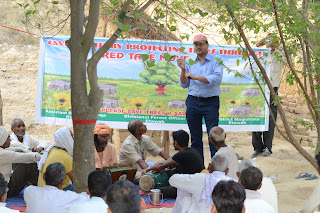.jpg)






